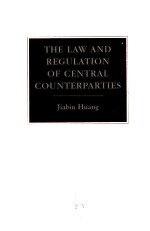
- 作 者:Huang
- 出 版 社:Hart Publishing Limited ; International Specialized Book Services (Distributor)
- 出版年份:2010
- ISBN:9781849460514;1849460515
- 标注页数:218 页
- PDF页数:228 页
请阅读订购服务说明与试读!
订购服务说明
1、本站所有的书默认都是PDF格式,该格式图书只能阅读和打印,不能再次编辑。
2、除分上下册或者多册的情况下,一般PDF页数一定要大于标注页数才建议下单购买。【本资源228 ≥218页】
图书下载及付费说明
1、所有的电子图书为PDF格式,支持电脑、手机、平板等各类电子设备阅读;可以任意拷贝文件到不同的阅读设备里进行阅读。
2、电子图书在提交订单后一般半小时内处理完成,最晚48小时内处理完成。(非工作日购买会延迟)
3、所有的电子图书都是原书直接扫描方式制作而成。
1 Introduction 1
1.1 The Purpose and Scope 1
1.2 The Chapters in Outline 3
2 Basic Elements of Post-trade Infrastructure 9
2.1 Introduction 9
2.1.1 The Importance of Post-trade Infrastructure 10
2.1.2 The Changing Landscape of Post-trade Infrastructure 11
A. Central Counterparty 13
B. Clearing 15
C. Settlement 18
2.2 Payment Systems and Securities Settlement Systems 20
2.2.1 Introduction 20
2.2.2 Payment Systems 22
2.2.3 Securities Settlement Systems 23
2.3 Modern Indirect-holding Structure and Book-Entry Securities 24
2.3.1 Introduction 24
2.3.2 Indirect-holding Structure 25
2.3.3 Book-entry Securities 27
2.3.4 Transfer of Book-entry Securities 30
2.3.5 Concluding Remarks 32
2.4 Relevant Developments in Shaping the Future of Post-Trade Infrastructure 32
2.4.1 Delivery Versus Payment (DVP): Horizontal Linkage between Payment and Securities Settlement Systems,Various Forms of DVP 32
A. UK CREST 35
B. CREST DVP Process 36
C. Self-collateralisation in CREST 37
2.4.2 Straight-Through Processing (STP): Vertical Linkage between Different Tiers of Holding Systems 37
A. The Drive towards STP 39
B. Benefits 40
C. Challenges 40
D. The Role of CCPs in STP Process 41
E. Market Development 41
2.4.3 Concluding Remarks 42
2.5 The Future of Post-trade Infrastructure 42
3 The Functional and Operational Aspects of Central Counterparties 44
3.1 Origins and Historical Development 44
3.1.1 Cheque Clearing (Timeline: from 1773) 45
3.1.2 Commodity Clearing (Timeline: from 1883) 48
3.1.3 Central Counterparty Clearing (Timeline: from 1888) 49
3.1.4 Concluding Remarks 51
3.2 The Functional Aspects of CCPs 52
3.2.1 CCP as Risk Manager 52
3.2.2 CCP as Fund Manager 54
3.2.3 CCP as Payment and Settlement System Operator 56
3.2.4 CCP as Post-trade Market Facilitator 57
3.3 The Operational Aspects of CCPs 59
3.3.1 Risk Operations 60
3.3.2 Treasury Operations 62
A. Specially Arranged Payment Scheme 62
B. Margining Operations 63
C. Operations for Other Services 65
3.3.3 Settlement Operations for CCPs 65
A. Trade Registration 66
B. Pre-netting 67
C. Netting Process 68
D. Post-netting 68
E. Settlement 69
F. Major Factors that Affect Settlement Operations 70
G. UK CREST 71
3.4 Concluding Remarks 72
4 Legal Issues: The Key Relationships 73
4.1 Introduction 75
4.1.1 Trading Rules and Clearing Rules 77
A. Trading 77
B. Trading/Exchange Rules v CCP Clearing Rules 78
C. The Timing Issue 79
4.1.2 The Conditions for Transaction Acceptance/Registration 80
4.1.3 The Results 82
4.2 Overview of the Key Relationships 82
4.3 The Relationship between CCPs and Their Members 86
4.4 The Relationship between Clearing Members Themselves 89
4.5 The Relationship Between Clearing Members and their Clients 90
4.5.1 The Nature of the Relationship 91
4.5.2 The Relationship between the Two Different Clearing Arrangements 92
4.5.3 The Legal Position of Clearing Members affected by CCP Clearing 93
4.6 The Position of Clients of Clearing Members 95
4.6.1 The Effectiveness and Implications of Implied Terms:Clearing Rules and Regulations as Implied Terms 96
4.6.2 The Rights of Clients of Clearing Members 96
4.7 The Relationship between CCPs Themselves 98
4.8 Concluding Remarks 99
5 Default Procedures and CCPs' Default 101
5.1 Collateralisation and Financial Collateral Arrangements 101
5.1.1 Types of Collateral 102
5.1.2 The Use of Collateral 103
A. Collateralisation in DVP Arrangements 103
B. Collateralisation in Payment Systems 103
C. Collateralisation in CCPs 104
5.1.3 The Limitation of Collateralisation 105
5.1.4 Characterisation and Realisation 105
5.2 Netting and Set-off 108
5.2.1 Netting 108
5.2.2 Definition and Distinctions 109
5.2.3 Settlement Netting 112
5.2.4 Novation Netting 114
5.2.5 Close-out Netting 116
5.3 Default by a Clearing Member 117
5.3.1 Commencement of Default Procedures 119
A. The Prescribed Events that Trigger Default Procedures 119
B. Procedures to be Followed 120
C. Close-out of Positions 120
5.3.2 The Effect of Default Procedures on Other Clearing Members and Third Parties 122
5.4 Default by a CCP 122
5.5 Concluding Remarks 125
6 Regulatory Issues 126
6.1 The Purposes and Objectives of Financial Regulation 126
6.1.1 The Purposes and Objectives of Financial Regulation 126
6.1.2 The Interaction between Financial Regulation and the Markets 129
6.2 Regulatory Approaches 132
6.2.1 The Modes of Financial Regulation 132
6.2.2 The Risk-based Functional Approach 135
6.2.3 The Interest of Central Banks 137
6.3 CCPs and the Regulatory Regime 139
6.3.1 The Need for Separated Treatment for CCPs 139
6.3.2 CCPs as Self-Regulatory Organisations 141
6.3.3 The UK Regulatory Regime 143
A. Market Contracts, Market Charges and Default Rules 145
B. Roles of Relevant Authorities 149
C. Competition Issues: A Special Competition Regime 150
D. The Effect of Recognition 152
6.4 Current Situation in the European Union 155
6.4.1 The Current EU Initiatives 155
6.4.2 The EU Directives 161
A. The EU Directive on Directive on Settlement Finality 161
B. The EU Directive on Directive on Financial Collateral Arrangements 162
C. The EU Directive on Markets in Financial Instruments Directive (MiFID) 163
6.4.3 The Challenges to the EU Regulators and Supervisors 164
6.5 Concluding Remarks 166
7 The Case for a Single Multi-market Central Counterparty 169
7.1 Advantages and Disadvantages of CCP Clearing 171
7.1.1 From the Markets' Perspective 173
7.1.2 From Members' Perspective 175
7.1.3 From Non-members' Perspective 179
7.1.4 Concluding Remarks 180
7.2 The Case for a Single Multi-market Central Counterparty 180
7.2.1 The Raison D'être for a Single Multi-market CCP 180
7.2.2 The Benefits of a Single Multi-market CCP 182
7.2.3 The Risks of a Single Multi-market CCP 185
7.2.4 The Global CCP Initiative 190
7.3 European Union Developments 191
7.3.1 The Current Situation 193
7.3.2 The Argument for a Single Pan-European CCP 196
7.3.3 Future Prospects 198
7.4 Concluding Remarks 199
8 Conclusions 200
8.1 Modern Post-trade Infrastructure 200
8.2 The Legal and Regulatory Framework 201
8.3 A Single Multi-market CCP 203
Select Bibliography 205
Index 215
